Interviews with experts and opinion leaders from our research network
Given today’ s global economic uncertainty and extreme volatility in demand of commodities, some companies have become more receptive and inclined to change to ensure the sustainability of their businesses. Under the leadership of Cynthia Carroll, CEO of the global mining company Anglo American from 2007 to 2013, the organization was repositioned strategically, restructured and transformed to achieve operational excellence and strong profitability for the long term while supporting sustainable development. The company prioritized safety and actively engaged with stakeholders around the world to become the “partner of choice.” In this issue we ask Mrs. Cynthia Carroll, outside Director of Hitachi, Ltd., about how she, as the CEO of Anglo American, one of the world’ s largest mining companies, dealt with challenges within the industry and implemented restructuring of the organization while substantially changing its corporate culture in the forty-five countries where Anglo had a presence.
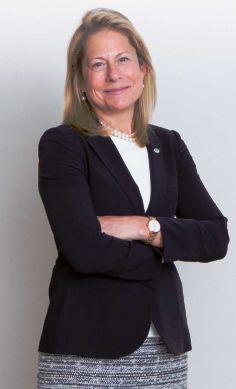
Mrs. Carroll earned a Bachelor's degree in Geology from Skidmore College, a Master’ s of Science degree in Geology from the University of Kansas and a Master of Business Administration degree from Harvard University. She joined Amoco Corporation in Denver, Colorado in 1982 where she
began work as a petroleum geologist. She joined Alcan Inc. in 1989 where she managed a packaging company in Kentucky and from there went to Ireland where she led an alumina business for 4 years. She then moved to Montreal where she was president of the bauxite, alumina and
specialty chemicals business. In her last five years at Alcan, she was the President and CEO of Alcan’ s Primary Metal Group, a global business which became the most cost competitive and productive aluminum company in the world. She then joined Anglo American PLC in January 2007 and
served as the Chief Executive Officer until April 2013. AFTSE 20 company and a leader in the global mining industry, Anglo American employed approximately 150,000 people and operated in 45 countries spanning Africa, South America, Australia, North America and Asia with about 90% of its operations and projects in developing countries. She joined the Board of Directors of BP in 2007. Last June, she joined the Board of Directors of Hitachi, Ltd. where she is actively involved in the development of new growth strategies.
Kawamura: First of all, could you please tell me about your impression of Hitachi when you first joined our Board of Directors?
Cynthia Carroll: I am hugely impressed with the people I have met. It is a company that has name recognition and enormous respect around the world. Hitachi produces the highest quality products and is very sophisticated in itstechnology and innovation. The receptiveness and openness of the Chairman and the CEO are evident as they actively seek different perspectives. They aim to be world class in all aspects of the Hitachi businesses and recognize that in order to become truly global, diversity of thinking and experiences is key. I am also impressed with the breath of the board discussions and the level of engagement and interact ion. The executives are listening, reflecting, and responding to input. I am proud to be part of this organization and look forward to contributing to the company’ s development, strategy and value creation.
Kawamura: You have experience gained over many years of working for global companies such as Amoco (a US petroleum company), Alcan (a Canadian aluminum company) and Anglo American (a British mining company). I suppose that the speed of decision-making is the key in the global field, but sometimes we lag behind. What do you think are the factors that allow Euro-American companies to make the decisions faster than Japanese companies? And what kind of measures might be implemented by Japanese companies to change this situation?
Cynthia Carroll: My background is in running a UK-based globally diversified mining company, Anglo American, for over 6 years and before that I led Alcan’ s aluminum business (which represented about 75% of the company when I left). I worked for Alcan (Aluminum Company of Canada) for 18 years where I ran various businesses. When I was CEO of Alcan’ s aluminum business, we substantially repositioned Alcan in the aluminum industry while simultaneously reducing costs so that the Alcan Primary Metal Group achieved the highest returns, profitability and growth in the history of the company. I have been fortunate to have lived in different countries and managed global businesses. Today, shareholders expect companies and their executives to be fast to respond, flexible, and willing to change the i r game plans. Howeve r, the re are advantages and disadvantages to that, particularly when running a resource-based company with time frames of 50 to 100 years and when shareholders are looking for almost immediate returns. It is therefore not hard to understand that there can be conflicts between the short term returns expected by some shareholders and the decisions and investments that the chief executive and executives make for the long term. Hitachi is a very stable organization with an impressive history and an employee base that is long serving; this creates pride and commitment in the organization. At the same time, there are challenges in understanding the global nature of business and the need to respond quickly.
The time horizons in Japanese and other companies in this part of the world relative to those in North America or Europe can be very different. As a leader, I tried to create a flat organization at Anglo American by pushing decision-making to the lowest level of the organization and creating an organizational culture striving for performance while being unified and connected through common standards and objectives. We also communicated regularly with our employees. When I started at Anglo I traveled around the world, visiting representative operaons, meeting management teams and employees and stakeholders, which included government and union leaders. It was apparent that we were not a unified organization with common objectives tied to a clear vision and ambition. As an example, I went to Australia and realized that the mine managers who operated at short distances from one another rarely met to compare their results and best practices. We launched a global initiative called Asset Optimization, which ensured that employees worked every day to enhance the value of their decision-making and output along the entire value chain of each business and operation. We began our initiative in Australia where it was clear to me that there was a lot of work to be done and potential for improvement.
In the metallurgical coal business in Australia in 2007, we showed a loss of about $7 million dollars; however, in 2011, we showed a profit of about $1.2 billion. In 2012, we achieved the highest productivity in the metallurgical coal industry in Australia in open cut and underground operations, which was thought to be unachievable a few years earlier. We did this by creating a system whereby people knew at all times how they were performing and what they needed to achieve. We became much more aware of how we were positioned relative to our competitors and what we needed to do to outperform substantially. The difference between European and Japanese companies comes back to the speed of decision making and having a flat organization with business leaders who have global experience. The common language at Anglo i s Engl i sh whi le the execut ive team was represented by eight nationalities and people who had operated internationally for most of their careers. The majority had lived and worked in multiple countries outside of their country of origin. They had run different businesses and in some cases, had worked in various functions.
My belief is that better solutions to problems are found through input from those of different perspectives and experiences. We were aware at all times of how we were functioning as One Anglo, how we needed to pursue synergies and streamline our processes and systems, how we needed to be learning about best practices everywhere and how we were performing relative to the competition. And critically, while we sought to build consensus in decision-making, it was clear that significant decisions rested with the executives and ultimately, with the CEO. At Anglo American, we implemented corporate and business unit strategies that were underpinned by a streamlined organizational structure. We pushed decision making to the lowest levels possible to ensure quick response times and agile operations. People needed to be equipped to make the right decisions. They were trained, their boundaries of responsibility
were clear and they were supported by experts. Ongoing communications were essential to gain understanding by the organization and managers of how we were doing relative to our budgets and other commitments. I was never satisfied with doing well as I always wanted us to do better and I was certain that this was possible.
Kawamura: For corporate governance, we have adopted the US-style corporate governance structure. What are your thought s on the respective roles of the shareholder meeting, board of directors, and board of executives in global companies?
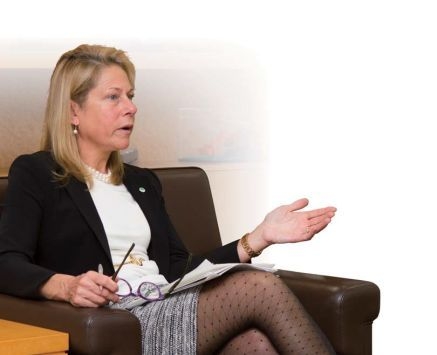
Cynthia Carroll: The primary role of the board of directors is to protect the interests of the shareholders. The board’ s role is to debate the corporate and business unit strategies, confirm the strategies, ensure delivery of budgets and plans by the executives, and to suppor t the organizational structure and development of the top team. The board must deal at times with threats to the company and take appropriate measures to protect the company’ s finances and ensure proper resource allocation. The board must strike a balanced position in meeting shareholders’ interests over considered time horizons and supporting the CEO and executives in their decisions as expert s and leaders of the organization.
The role of the board of execut ives (executive committee) is one of performance and execution of commitments. The members regularly update and present to the board of directors strategic recommendations and issues that are the result of considering a wide range of options. The board of executives oversees the organizational structure, selection of the company’ s leaders and works to develop the talent pipeline, which includes future successors. It is the role of the board of executives to engage with a multitude of stakeholders on a regular basis, taking an open and transparent approach. When I attended the Hitachi AGM in June, I was enormously impressed with the openness of the dialogue and the desire to engage so f reely wi th the interes t in supporting shareholders and answering their questions.
Kawamura:
In the past, the shareholder meeting used to be quite formal, but recently, shareholders have begun to ask us honest questions and we intend to answer them as far as we can. Could you tell us the approach of the stakeholder’s communication at Anglo American?
Cynthia Carroll: Yes. The level of interest and expectations of the s takeholde r s and shareholde r s are changing. Governments are looking to resource companies to invest more in basic infrastructure (roads, power, housing, ports, and rail systems) because they themselves don’ t have the wherewithal to do it. Communities are seeking a heightened level of understanding of what the resource companies intend to do over the long term and how they will benefit in terms of employment, infrastructure development of their region and direct financial gains. Anglo American created trust funds and equity sharing arrangements with communities. We were also focused on job creation outside of mining. When I joined Anglo American in 2007, we had a project operating to address this with one office in Johannesburg. I felt that we should expand it to reach out and work to create non-mining jobs in the regions where we operated. When I left Anglo American, we had over 30 hub offices in South Africa and had taken this model to Peru, Chile and Brazil. We had created close to 50,000 non-mining jobs in the communities, which will substantially contribute to ensuring that the communities are economically sustainable and not solely dependent on mining. Anglo American was the only mining company in the world to be selected by the United Nations to respond to the UN Millennium goal initiative around job creation, which we did. Shareholders are working to understand the balance between financial returns and what is required of companies to create sustainable businesses for the future. Today, it is not about the resource companies investing, extracting the resources, and then leaving 20 or 30 years later. As we looked at investments at Anglo American, our approach was to create an economic framework and environment whereby the community was better off after the mine gate was closed than before i t had opened. I t was my aim to create economically sustainable regions for the very long t e rm. In order to achieve the right level of understanding and balance of stakeholder interests, we had to be transparent and open in our engagement at all levels. An example of this was in Peru, where a few years ago there was a call from stakeholders and the communities to stop mining companies from developing resources. I spent t ime with President Garcia, fol lowed by President Humala, to discuss what was needed to help the government and the communities understand how we would develop the project in terms of considering issues such as water usage, protection of the environment, job creation, training of our employees, etcetera. Before we were to make a final investment decision, we launched a “dialogue table” where we debated issues with 28 different stakeholder groups for 18 months. We f inal ly took the project to the stakeholders for a vote in support of the project. It was on this basis that we decided to move forward and President Humala declared that Anglo American had created the model for stakeholder engagement and resource investment in the country.
Kawamura: The 28 stakeholders’ opinions might be very different and you cannot satisfy all of them.
Cynthia Carroll: No, you cannot. You have to be clear about what you are trying to accomplish and how you need to get there, what is acceptable and what is not, and what the rules of engagement are. You need to strike an understanding of how you are going to work in unison and frame, together, a vision of success for the long term. In the resource sector, it is of paramount importance that companies work hand-in-hand with governments
around the world at the local, regional and national levels to create win-win situations for the very long term. I personally spent a lot of time with heads of states and government officials in all countries where we operated or were considering an investment in order to gain a joint understanding of how we needed to act together.
Kawamura: You served as the first female, non-South African CEO of Anglo American from 2007 until April 2013. During this period, the mining industry faced both supply and demand side challenges, such as a sharp fall in commodi ty pr ices due to the global economic slowdown while there were labor-management issues in some parts of the world in some of the industry’ s mines. In such a difficult situation, I suppose that you had many challenges and it was an intensive time to transform the company’ s businesses as well as the corporate culture. Could you tell me what you faced when you arrived at the company, and what actions you took as the leader of a mining company to deal with these challenges?
Cynthia Carroll:When I joined Anglo in 2007, we identified a vision and objectives that were clear and where everyone in the organization played a role in contributing to the bottom line. We needed to be aligned and we needed todefine our strategies at the business and corporate level. This was underpinned by a new, streamlined organizational structure where the business unit leaders were relocated to the region where their business had the largest concentration of operations. We established detailed fact bases about the markets we were in and how they were likely to evolve over time. We ended up selling over $11 billion worth of assets in order to become a more focused mining company. We launched two cost saving initiatives and committed to delivering $2 billion of value over 3 years; each person was aware of the initiatives and our objectives. Ultimately, we delivered $3.2 billion in the same time period.
We also prioritized safety since Anglo American was losing about 46 people every year between 2002 and 2006 to fatalities. This became a common objective that everyone could relate to-saving lives. It is my belief that a strong culture of safety translates into a strong business culture because people must be rigorous and disciplined as they work as a team. We ended up reducing the number of fatalities from 44 in 2006 to 13 in 2012.
As I have already mentioned, we were very engaged with stakeholders at all levels and I emphasized to everyone that they were ambassadors of Anglo American, at all times. Our aim was to become the “investment of choice, partner of choice and employer of choice.” During my tenure at Anglo American, we experienced two extreme economic downturns, in 2009 and 2012. At the same time, we had two years of record profits 2008 and 2011. In 2011, we made $11.1 billion of operating profit. Even in 2012, five of our eight business units showed record production. During those economic downturns, we had to respond and prioritize our capital spending. While we reduced our overhead substantially and cut back our capital by 50%, we continued to invest in our four major projects that we believed would deliver significant cash in the short term. In 2012 as the projects came on stream, they added $1.2 billion to our bottom line.
I believe that the culture of the organization was transformed at Anglo American during my tenure. The organization had become aligned and focused. We were clear about our strategic direction for the medium to long term and our short-term objectives. It became a performance- oriented culture with values of care and respect for each individual. However, changing an organization’ s culture doesn’ t happen overnight. It takes a long time to get people to change permanently while embedding a different mindset and orientation. The work to do this is still ongoing.
Kawamura: A mining company has big ups and downs.
Cynthia Carroll:In the recent years, the economic cycles have been much shorter. Hence, we worked to have a focused strategy and to create an asset base that delivers value through each par t of the cyc l e ; i ron ore and metallurgical coal at the beginning part, copper and nickel in the midstream, and platinum and diamonds at the end of the cycle. No other mining company in the world has that breadth of commodities that can deliver value across the cycle. We also worked to drive the operations to the lowest end of the cost curve so that no matter what the economic conditions were, we were able to deliver value. The majority of our businesses became very cost competitive.
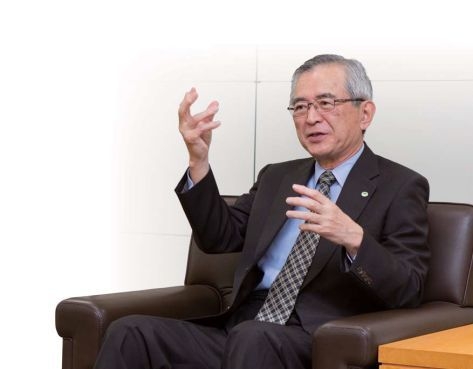
Kawamura: China’s rate of growth has decreased a little and the US economy has not recovered as much as expected, so this might be a difficult time for mining companies.
Cynthia Carroll:In the medium to long-term, I am bullish on the mining industry. Commodities will be in significant demand for decades to come. However, the quality of resources is declining and access to them is becoming more difficult as companies are looking to places like Africa or the Arctic to explore for new reserves. As I mentioned previously, governments, particularly in developing countries, are looking to mining companies to invest more in infrastructure and are trying in many cases, to extract more benefits from the companies through various means such as increased taxes or even direct ownership. We at Anglo American always targeted large-scale tier one assets that would be low-cost and could be expanded, but those are harder to find. The companies that will be successful in the industry in the future will be low cost, selectively targeting the value enhancing commodities, and able to
navigate the government and stakeholder complexities in challenging jurisdictions. Growth in China has come down significantly, but urbanization of China will continue for the next 20 years, at least. Additionally, the size of the middle
class in India is massive with around 300 million people; this is expected to grow to about 585 million people by 2025. Other developing countries have great needs of natural resources, as do developed countries like the United States. On balance, I am optimistic about the industry as demand continues and supply of some key resources like copper is more constrained.
Kawamura: I have heard that mining companies are trying to increase the productivity of mine operations in the current unstable market situation. As one example, companies are trying to innovate through the use of automated dump trucks and so on. What kinds of technologies will be expected to contribute to such innovation in the future?
Cynthia Carroll:It is early days in terms of the development of breakthrough technologies in mining. Thus, there is opportunity for equipment suppliers to serve the industry differently than in the past through the development of innovative applications. They need to work in partnership with the mining companies to find ways to improve operating and energy efficiencies of vehicles or tools along with improving the monitoring IT systems. These together can have substantial impacts on productivities and ultimately operating costs. The concept of virtual mining and operating multiple facilities from one central control room is relatively new and only a handful of companies have
implemented this effectively. Remotely controlled dump trucks that are unmanned are fairly unique. Low profile vehicles are being developed to access ore bodies that are more difficult or dangerous to reach. “Smart” detection systems in mining equipment ensure safer movement of vehicles and protect ion of equipment.
In Australia, about 70% of the output was from open cut operations where Anglo American had achieved the highest productivity while it was planned that in the future, about 70% would come from underground facilities. Hence, underground technologies had to be improved because access to resources is becoming difficult and challenging with thinner seams and more remote ore bodies. We worked closely with a US engineering firm to design long wall equipment that could be operated more efficiently through remote control systems and ensured higher utilization rates with reduced downtimes and associated maintenance. Many resources are in water stretched environments so efficiency of water usage is critical. We worked to reduce our water in our systems, creating dry processes in our iron ore operations in South Africa and found a way to recycle more water in places like Chile. The recent expansion of our Los Bronces mine included a recycling system that utilized 40% less water than the original system. Many improvements need to be made in this area; it is a priority for most companies.
Kawamura: In our experience, different people sometimes bring about innovation. The people within the society cannot bring forth a big innovation.
Cynthia Carroll:Yes. Very often they are too close to what they are doing and can’ t see the bigger picture or take a different perspective. Hence, we move people in and out of research labs. It is very positive to have people working in the research labs who have also had operational experience and to have scientists and technical experts working in our operations. It represents a tremendous opportunity to learn and develop in different ways, providing the individual with new challenges and broadening their experiences while enhancing the organizational flexibility in improving the mobility of people. I understand that the same approach i s taken at Hi tachi , which I think i s tremendous, especially in a company that is so focused on innovation and vast in product development.
Kawamura: The next question is about shale gas. It is assumed that, by the so-called Shale Revolution, gas will be an increasingly important fuel source primarily in the US, and fuel resource prices including coal will decline. How will the trends in commodity prices influence the business strategy of mining companies?
Cynthia Carroll::Clearly, shale gas is revolutionizing the United States fuel source and energy position, and the expectation is that in 10 years time, the US will be self-sufficient. This is likely to have a positive impact on the US economy; business strategies may change as companies view the US as a place to invest and grow for the long term, with access to a lower cost and cleaner energy source. It also will change the political/economic dynamics with respect to the US dependency on foreign fuel. It obviously has positive environmental implications as well. Regarding other parts of the world where there is a significant amount of shale gas such as China, it is unclear how this will be developed given that they don’ t have an established network of distribution systems, like the US. In essence, I believe that thermal coal will continue to be a major fuel source for many parts of the world such as China, India and South Africa, where they have access to low cost coal and systems that accommodate those resources.
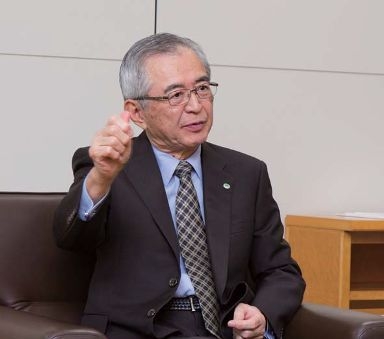
Kawamura: Then the US may become again the country of manufacturing.
Cynthia Carroll::There is a deliberate and progressive approach in the US to start up or restart businesses that did not have a future, such as aluminum, which is intensely dependent on energy. The US may regain a bigger manufacturing base as it offers competitive energy prices, labor costs,tax regimes and access to skilled workers. In recognition of this, the US needs to continue to develop more engineers, scientists, and technical capabi l i ty to suppor t a revived manufacturing economy.
Kawamura: Some people expect the total GDP of China to reach the US GDP in 2020, but that may not be possible due to the development of the US.
Cynthia Carroll::That is right. The US is a country of very determined people. Americans are not deterred by challenges and bond together in overcoming adversity. There is no doubt that the US will continue to represent a significant business force in the future.
Kawamura: Hitachi aims to be a “Globally Competitive Company” and we are promoting globalization to achieve the same prof i t rat io and cash f low l eve l s as our competitors such as IBM, GE and Siemens. How did you feel about the globalization and diversification of Hitachi when you actually attended the board of directors? Also, how can you advise Hitachi with respect to globalization and diversification, which are urgent issues for the company’s development?
Cynthia Carroll:I appreciate the drive that Hitachi is taking towards globalization and diversification in order to be truly competitive with the companies that you mention. My sense is that progress is being made and the fact that new, non-Japanese board members have recently joined is a testament to this. I also find that the board members themselves are worldly and keenly recognize the need to diversify. Globalization starts with the top team and exposing people to alternative perspectives and various parts of the world. It is important that people speak a common language and communicate in English, which is the global business language. Recruiting people from different backgrounds, different nationalities, different experiences, and different educational exposures is very important. This is particularly critical with respect to marketing and commercial matters.
Kawamura: Did Anglo American recruit new graduates and experienced people every year?
Cynthia Carroll: Yes. In Anglo, probably 70% of our employee base would have technical or financial backgrounds. In terms of recruiting young people versus experienced people, it was probably about 40/60, respectively.
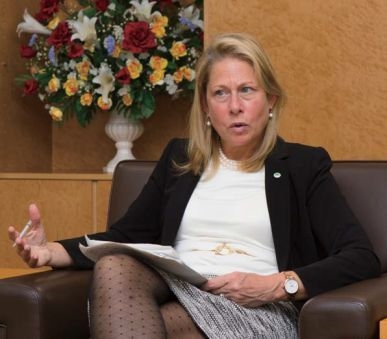
Kawamura: In our case, it is 90% young people versus and 10% experienced; 90% young people are educated within the company for long periods, which is time consuming.
Cynthia Carroll: It does take time. If we aim to be truly global and seek out different perspectives and think in different ways, we also need our executives to be from countries from around the world where we operate or where we want to create a presence to understand a market or get closer to particular customers, for example.
Kawamura: In Japan, newcomers represent 90% of our workforce and they are not accustomed to speaking in English, which is a big handicap.
Cynthia Carroll: There is no doubt that English is the common language spoken in business. It is a limiting factor in a global company if the majority of employees cannot speak English but certainly this can change with training, communications and conducting meetings in English. Despite having our operations mostly in developing countries, many where English was not the first language, we insisted that management and the business leaders spoke English. In Anglo American, most people spoke at least a second language if not a third or a fourth language.
Kawamura: Recently many events in this company are being held in English, so we are now practicing. Those activities are important because they are very motivational. In an increas ingly global iz ed bus ines s and as competition between companies speeds up, workforce diversification has received more attention as one of the key strategic imperatives to strengthen company competitiveness. Hitachi is promoting this. Could you tell me what is important in promoting diversity by the appointment of women and foreigners and so on? And what is the advantage of diversity among management?
Cynthia Carroll:Diversity comes back to having people with different backgrounds and different perspectives. As I mentioned, my view is that diverse input in debating issues and making decisions leads to having better choices, which ultimately leads to better decisions. When I arrived in Anglo American in 2007, the majority of the executives running the businesses were white men from the UK and South Africa. As I mentioned earlier, when I left Anglo this year, we had 8 nationalities represented on the top executive team (South African, Zambian, Zimbabwean, Brazilian, French, Irish/Australian, British and American) and one other woman. In 2007, there were virtually no women working in the organization and certainly not in underground operations where women were not even allowed to work 10 years ago in South Africa.
While I believed that women in our company would change the culture, I also recognized that there was a business imperative to employ women as we were seeking talented employees. For example, in places like Australia, we couldn’ t find people to drive our trucks in the opencast mines. It was clear that we needed to reach out to women and employ them at all levels of the organization in all types of jobs. We set targets that were tied to compensation. Anglo American had the largest number of women of any mining company in the world. About 15% of the total workforce was made up of women and 22% of management were women, working in functional as well as operational roles as operators underground, shift supervisors, operations managers and business unit CFOs. When I left, we were working towards a target of 30% women in management and 21% across the organization by the end of 2014.
However, to be successful in attracting and retaining women in any organization, the right conditions need to be established and this takes a commitment by management. At Anglo American, people at all levels needed to be trained about diversity in the workforce, as we needed to create facilities underground for women, supply new clothing, examine planning and scheduling of work hours, and provide childcare facilities. Although this sounds like a lot of work, having women in the workforce was one of the catalysts for cultural change and driving our values, particularly around respect. This does not happen automatically, but only through commitment from the top across the organization. Anglo American still has a long way to go but is definitely on the right track.
It is great that Hitachi has created a global human resource database, which is critically important to the development of the organization and the talent for the future. These databases highlight critical jobs in the organization, the requirements for those jobs and the skill sets needed for them. Regular conversations every year need to take place with each individual in the talent pool, to discuss their performance and future, including their ambitions, their degree of mobility, and areas for development, which is backed up with a plan.
Kawamura: This is the first time we have implemented a global grading for each person except for welders and assemblers. Although we have not yet put it into actual operation, we will utilize the system going forward.
Cynthia Carroll:Given the numbers of people working in Hitachi, creating such a global grading system is quite an achievement. As I am sure you know, the system will need to be utilized consistently across the organization and updated regularly. It will be beneficial in the overall management of resources and planning. Such a system can add discipline to the evaluation process and ensure that managers are providing feedback, in a common format, to employees about their performance.
Kawamura: You are a working woman and you have four children. Did you face difficulties in being there for them along with your work?
Cynthia Carroll:We are a close family. I am fortunate because I have a wonderful, hugely supportive husband. He is a certified public accountant and has a master’ s degree in finance. I have been running businesses for most of my working career and had our first and second children when I was in Kentucky managing a packaging company. Our third child was born in Ireland where I was leading an alumina business and my husband was working for an accounting firm. When we moved to Montreal and I became responsible for a global business with Alcan and I had our fourth child, we decided that he would stay and work from home, which would allow me to travel. It was not an easy decision, because he had his career, but that was the only way we could balance our life with our four children and give them the attention that they needed.
I have always been very connected to my children and involved in their lives, despite the travel and demandsof my jobs. I believe that women can have a family and work at the same time; this can be achieved by striking a balance, prioritizing, having a supportive partner, being extremely organized and good at delegating and knowing that you cannot do everything. Today it is much easier to keep in touch because of technology.
Kawamura:During this Kentucky period, did you use a daycare facility?
Cynthia Carroll:In Kentucky and Ireland, my husband and I both had full time jobs. We hired a woman who lived in our home with us who looked after the children during the day.
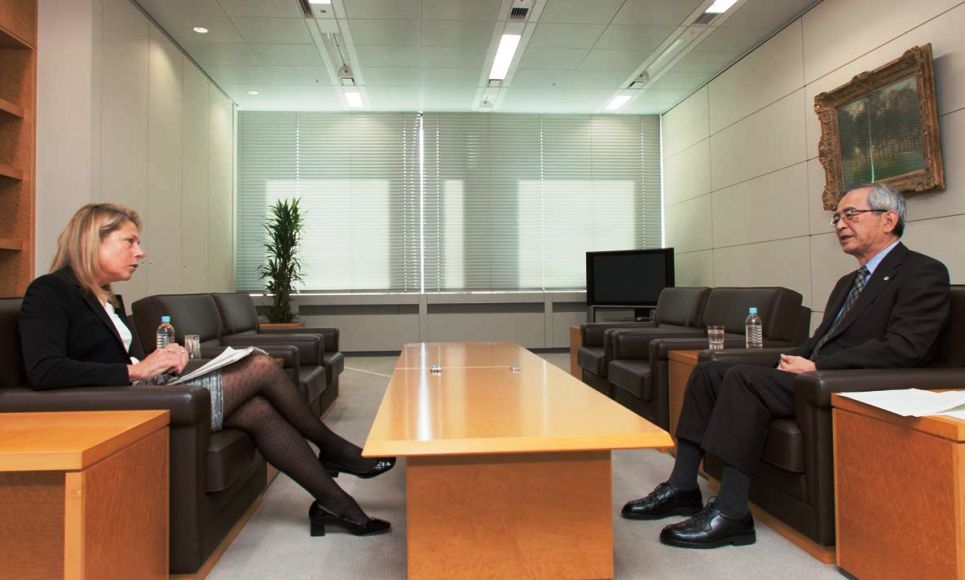
Kawamura: In Anglo American, do many women follow a similar approach when they have children?
Cynthia Carroll: Many do not have the luxury of hiring someone to come into their homes, as they simply don’ t have the financial resources. Some more fortunate women have parents who will look after their children during theday, although this is fairly rare. In Alcan, we had a daycare center attached to the office, which had outstanding teachers and facilities. In Anglo American, we introduced more daycare centers, while also working with women to accommodate their family demands by offering more flexible work hours or exploring job sharing with other women. In the mining industry in South Africa, once a woman discovers that she is pregnant, she cannot work underground.
This puts pressure on the manager in charge to balance out workload assignments and distribution of employees. A woman will work above ground while she is pregnant, go on maternity leave and then be reintroduced to the workplace after being away from her job for possibly two years, all in an industry environment of intense competition for jobs and requirements to perform. The mining sector is particularly challenging given the physical demands of the jobs along with the contextual and cultural setting. Having said all of this, with the right mindset amongst management, innovative solutions can be found. As I have mentioned already, women in the workforce can substantially change the culture of an organization. The executives at the top have to create the positive conditions and context for women to thrive if women are to be truly integrated. In my view, this leads to an organization that is broader in its thinking and approach in a global business world.
Kawamura: How many months off do they take when they have a child?
Cynthia Carroll: This varies by country and regulations. I worked up until the very day I had my children. We had 6 weeks of paid maternity leave at Alcan but for the most part, I took only a portion of this because the businesses needed my involvement. In many European countries, women can take off almost one year of paid or partially paid leave and now there is also paternity leave available. Ultimately, it is a judgment call for women to decide how much leave they will take and what the impact might be to their jobs, incomes, families and careers. There is no doubt that it is a challenge for the employer as well as the individual to juggle these factors but by working together, they can be overcome.
Kawamura: In Hitachi, company regulations allow three years leave, but almost all the women return after one year or less because they are anxious about their careers.
Cynthia Carroll: This is completely understandable. If a woman has been out of the mainstream business for two to three years, it is hard to get back in unless she returns to school and gets additional degrees.
Kawamura: Do you have some advice to Japanese working women?
Cynthia Carroll: My advice to anyone is to stay focused on doing the best at the job that you are doing and don’ t be preoccupied with where you might be in five or 10 years. Keep an open mind and don’ t avoid taking on new challenges or unfamiliar assignments. Try to be part of a network of women in the workplace with whom you can discuss issues or concerns. Ensure that your communications skills, both written and verbal, are strong. Communicate with your boss and other management in the organization and provide a sense of what you would like to achieve and seek their input on your career development. Express openly concerns or observations that might help the organization to integrate women more effectively. And above all, be yourself.
Kawamura: How do you spend your free time? What are your hobbies?
Cynthia Carroll: My top priority is my family. What free time I have, I spend it with my children and husband, David. We love sports including golf, tennis, skiing, swimming and horseback riding. Carin, our second daughter, rows (crew) at university and our son, Ben, plays a lot of soccer so we try to watch them often. We enjoy music, both listening and playing. My children play different instruments at various levels. My youngest daughter, Kerstin, is wild about acting and drama so we also attend the theater regularly.
Kawamura: Do you yourself play some instruments?
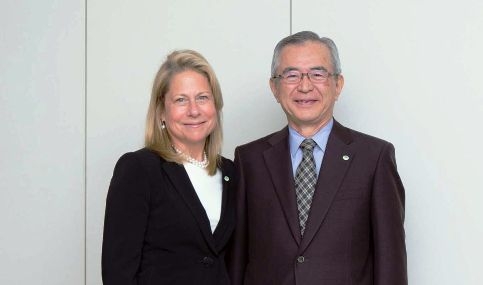
Cynthia Carroll: I played the piano a bit, ages ago but I was never very good. I have been coaching my children since Britta, the oldest who is now 20, started playing piano at about 6. She also plays the French horn in a wind symphony orchestra and I try to get to as many performances as possible as they are simply inspirational.
Kawamura: Do you go fishing?
Cynthia Carroll:: We have a summer place on the St. Lawrence River in the Thousand Islands between Canada and the United States, and there is a lot of fishing. I grew up fishing with a father who was an avid fisherman. Some of my children love to fish. We have a little island, where we swim, sail, kayak, and play tennis and golf. We travel everywhere in small boats.
Kawamura: With your tremendous success and broad range of experiences, what are your dreams for the future?
Cynthia Carroll: I want to keep working and being part of organizations that strive to be world class and the best in their industry, making a difference to people, to communities, and to nations around the world while creating shareholder value.
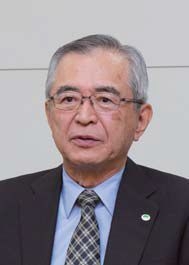
Mrs. Carroll worked for the world famous mining company Anglo American as CEO from 2007 to 2013. At the t ime she streamlined its organizational structure and changed corporate culture under a tough business environment due to global economic slowdown. In this interview Mrs. Carroll addressed a variety of topics such as corporate structural reforms, ways of corporate governance, the importance of globalization and diversification of human resources and advice to working women based upon her experience. Her leadership through difficult changes is impressive, as are her comments such as, “My belief is that better solutions to problems are found through input from those of different perspectives and experiences.”